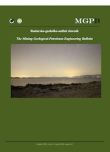A new approach for particle size characterization of soil based on dynamic image analysis (DIA)
DOI:
https://doi.org/10.17794/rgn.2019.4.9Keywords:
dynamic image analysis, fine-grained soil, MATLAB softwareAbstract
Particle size distribution (PSD) affects soil behaviour and plays a main role in geotechnical engineering. In site investiga- tions of large engineering structures, in earthquakes and liquefaction research and before filter material selection, it is necessary to make a number of PSD analyses. There are two popular techniques to determine PSD in the lab: sieving for the coarse-grained samples and hydrometer analysis for fine-grained samples. However, determining the PSD of soil in the lab has some challenges such as time, labour, difficulty and errors related to the analysis. The newly developed dy- namic image analysis (DIA) method based on wavelet transformation (WT) analysis is used as the main approach for determining particle size distribution. The DIA method contains saving the image and processing it with the software for a specified goal. The DIA method holds many advantages over the hydrometer analysis, including automating the test, reducing errors, monitoring and evaluating the particles at any time. In this paper, the PSD of fine-grained soil with a plasticity index (PI(=30 has been determined. The images of soil were prepared with a digital camera at a different time when particles settled through a sedimentation cylinder and were analysed with MATLAB software. The results were compared with the hydrometer analysis. The results showed that at t=15 min, a complete overlapping was seen between the DIA method and hydrometer analysis. The D20, D50 and D80 values by the DIA method were determined respectively, 0.0017, 0.012 and 0.031 mm at t=15 min. The results demonstrated that the DIA technique can be implemented for all types of fine-grained soils, more easily than the hydrometer analysis. The differences between the methods’ results were raised due to the amount of data provided by them.
Downloads
Published
How to Cite
Issue
Section
License
Copyright (c) 2019 authors and journal

This work is licensed under a Creative Commons Attribution 4.0 International License.
Creative Commons-BY
Authors who publish with this journal agree to the following terms:
In agreeing this form, you certify that:
- You read the ethical codex of the RGN zbornik available at journal web.
- You submitted work is your original work, and has not previously been published and does not include any form of plagiarism.
- You own copyright in the submitted work, and are therefore permitted to assign the licence to publish to RGN zbornik.
- Your submitted work contains no violation of any existing copyright or other third party right or any material of an obscene, libellous or otherwise unlawful nature.
- You have obtained permission for and acknowledged the source of any illustrations, diagrams or other material included in the work of which you are not the copyright owner.
- You have taken due care to ensure the accuracy of the work, and that, to the best of your knowledge, there are no false statements made within it.
- All co-authors of this submitted work are aware of, and in agreement with, the terms of this licence and that the submitted manuscript has been approved by these authors.
Publication licence
You retain copyright in your submitted work, according to journal license policy (CC-BY). By signing this form you agree that RGN zbornik may publish it under the publication licence. In summary the licence allows the following:
Anyone is free:
- To copy, distribute, display, and perform the work.
- To make derivative works.
Under the following conditions:
- The original author must always be given credit.
- The work may not be used for commercial purposes.
- If the work is altered, transformed, or built upon, the resulting work may only be distributed under a licence identical to this one.
Exceptions to the licence
In addition to publishing the work printed under the above licence, RGN zbornik will also enable the work to be visible online.
The journal editorial can change the licence rules anytime but it cannot retroactively restrict author(s) rights.


